外研版(2019)选择性必修 第三册Unit 6 Nature in words Developing ideas and Presenting ideas名师教学设计
文档属性
| 名称 | 外研版(2019)选择性必修 第三册Unit 6 Nature in words Developing ideas and Presenting ideas名师教学设计 | 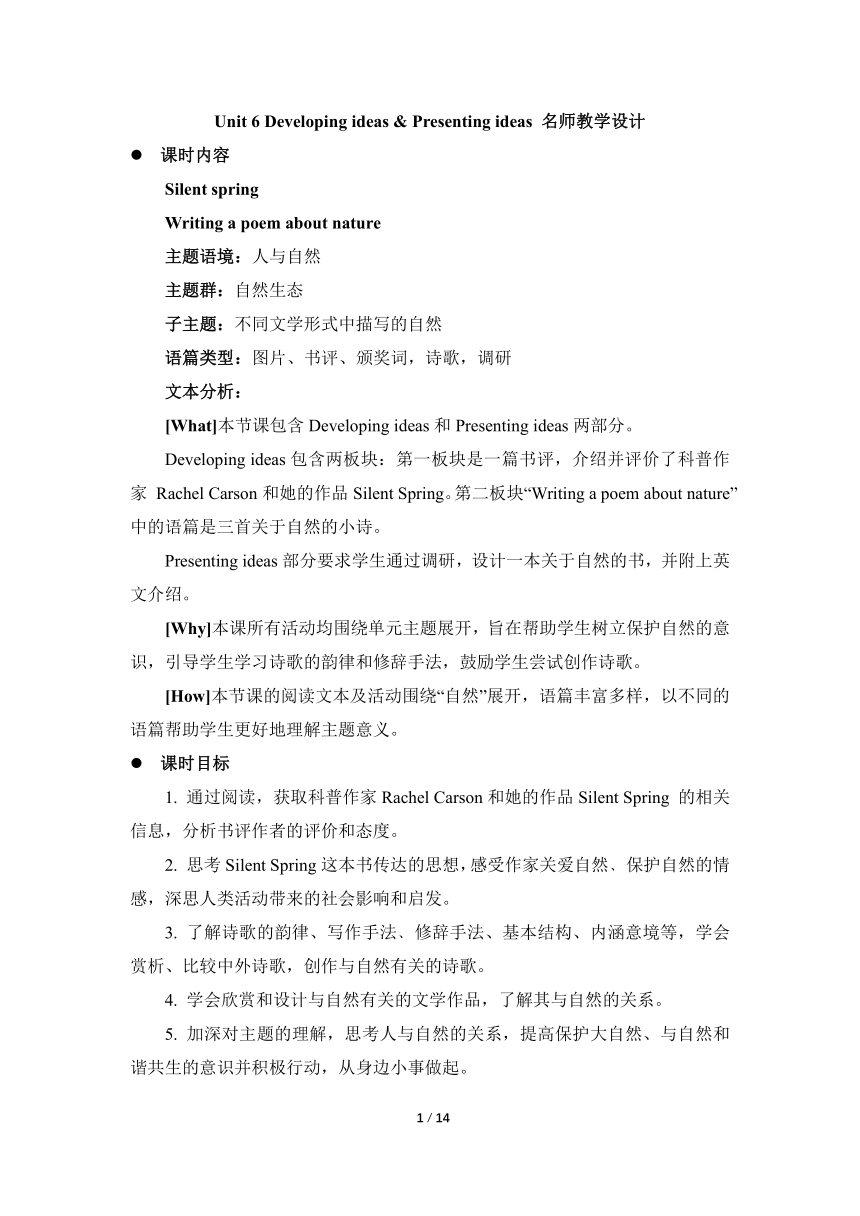 | |
| 格式 | docx | ||
| 文件大小 | 638.8KB | ||
| 资源类型 | 教案 | ||
| 版本资源 | 外研版(2019) | ||
| 科目 | 英语 | ||
| 更新时间 | 2023-03-06 21:45:27 | ||
图片预览

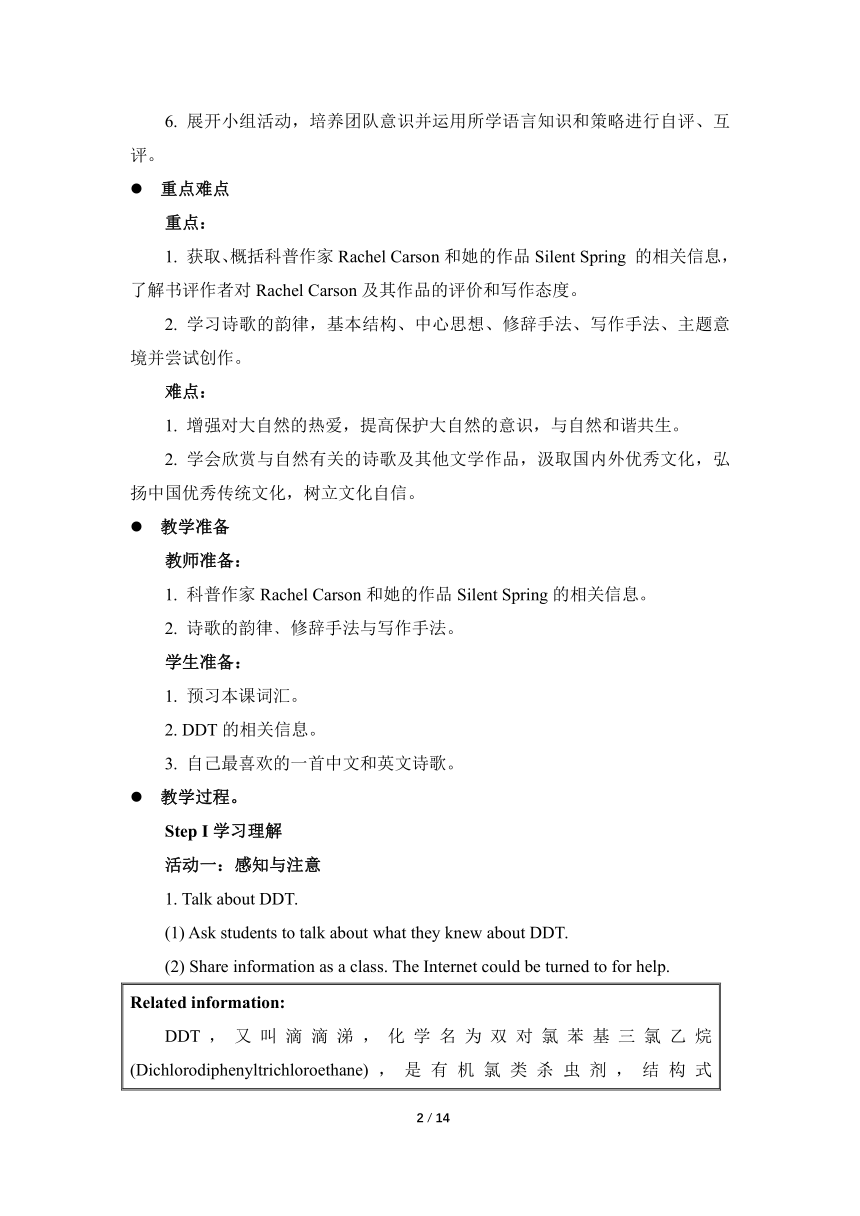
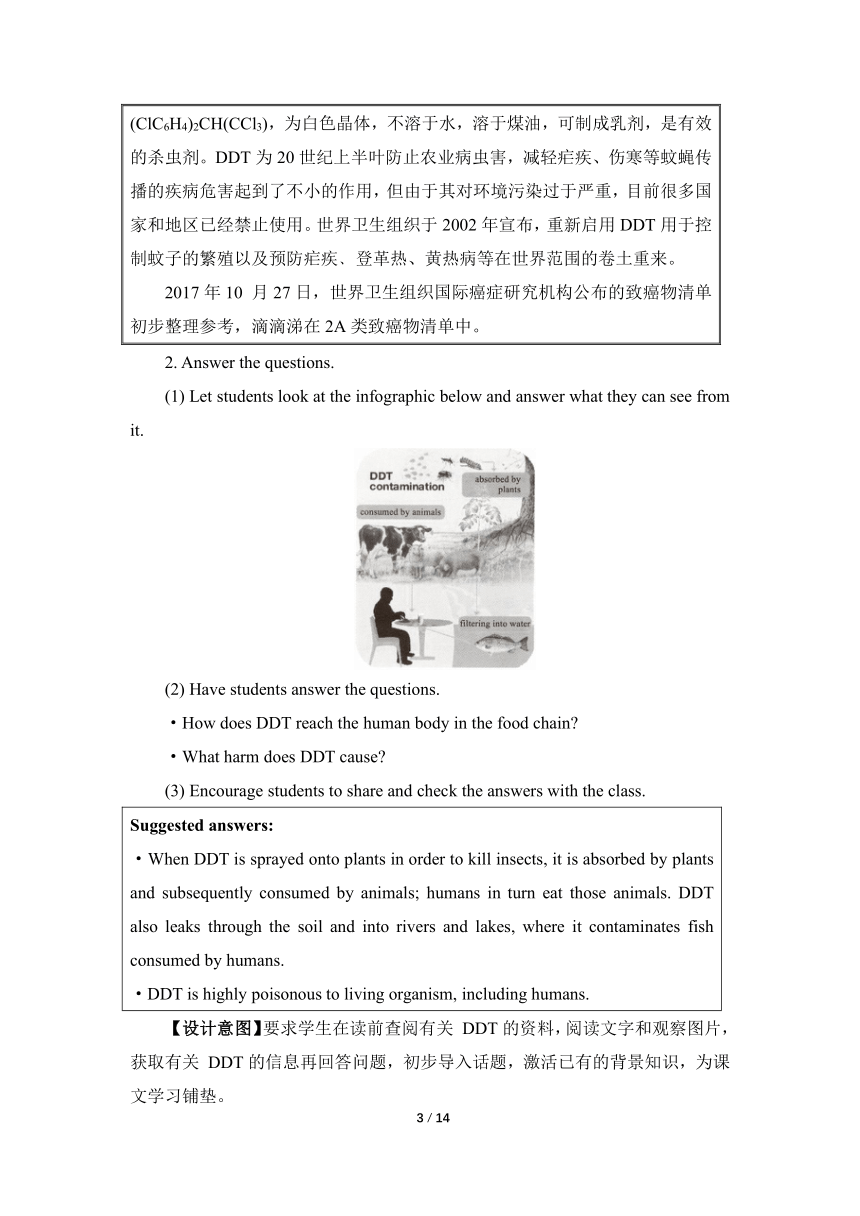
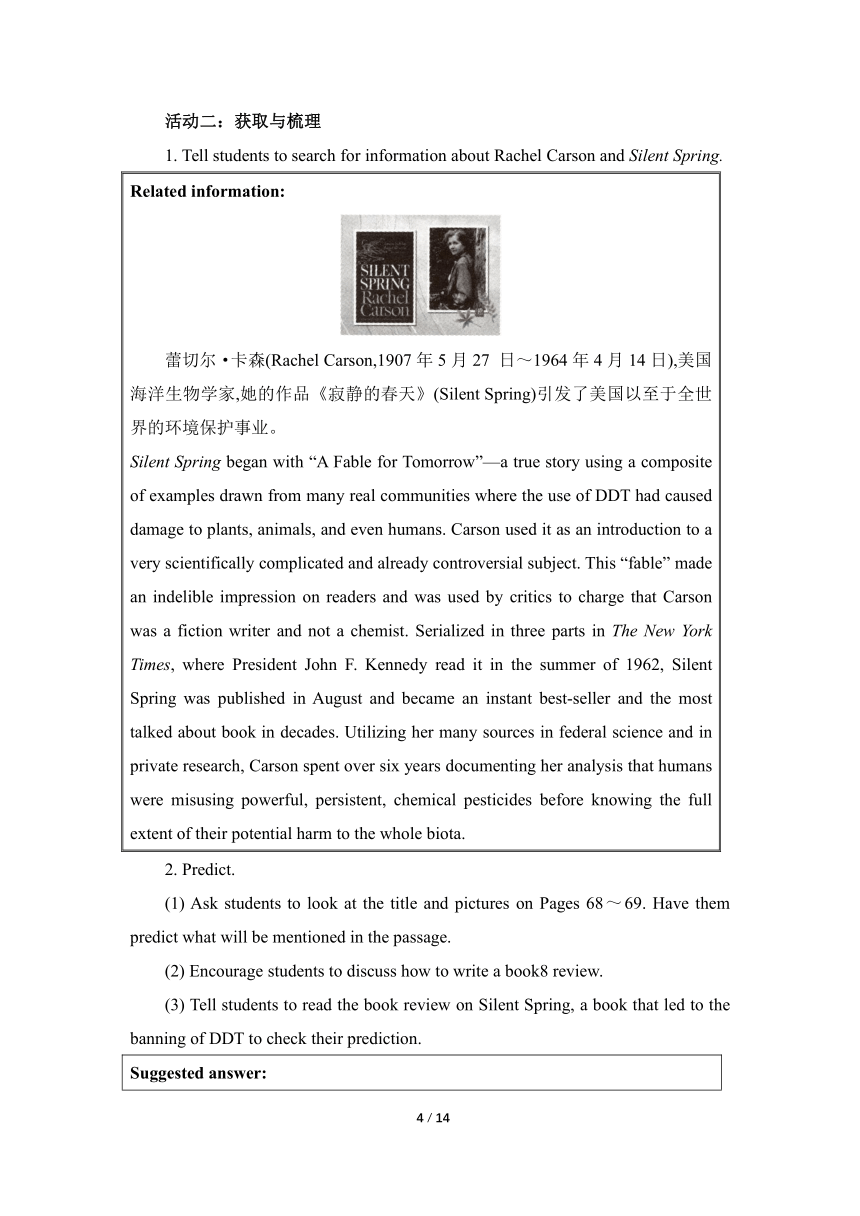
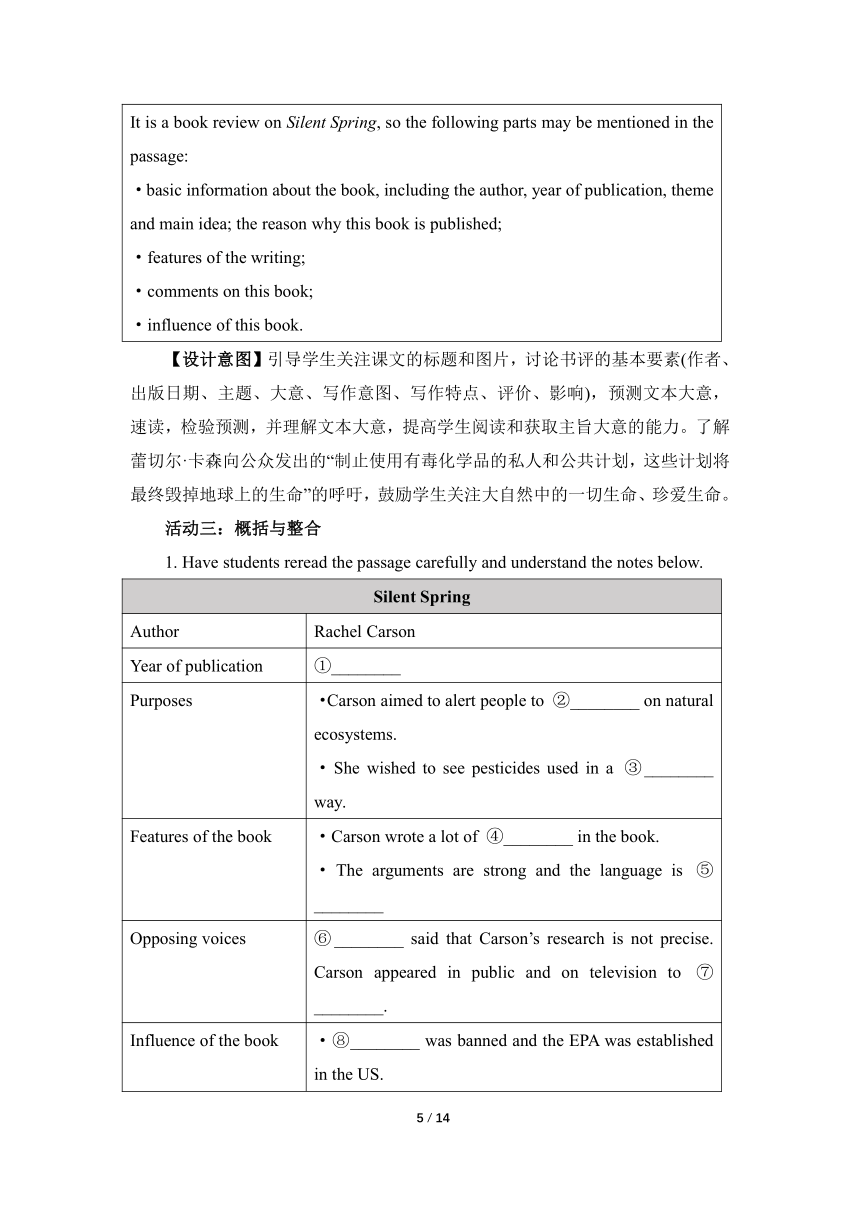
文档简介
Unit 6 Developing ideas & Presenting ideas 名师教学设计
课时内容
Silent spring
Writing a poem about nature
主题语境:人与自然
主题群:自然生态
子主题:不同文学形式中描写的自然
语篇类型:图片、书评、颁奖词,诗歌,调研
文本分析:
[What]本节课包含Developing ideas和Presenting ideas两部分。
Developing ideas包含两板块:第一板块是一篇书评,介绍并评价了科普作家 Rachel Carson和她的作品Silent Spring。第二板块“Writing a poem about nature”中的语篇是三首关于自然的小诗。
Presenting ideas部分要求学生通过调研,设计一本关于自然的书,并附上英文介绍。
[Why]本课所有活动均围绕单元主题展开,旨在帮助学生树立保护自然的意识,引导学生学习诗歌的韵律和修辞手法,鼓励学生尝试创作诗歌。
[How]本节课的阅读文本及活动围绕“自然”展开,语篇丰富多样,以不同的语篇帮助学生更好地理解主题意义。
课时目标
1. 通过阅读,获取科普作家Rachel Carson和她的作品Silent Spring 的相关信息,分析书评作者的评价和态度。
2. 思考Silent Spring这本书传达的思想,感受作家关爱自然﹑保护自然的情感,深思人类活动带来的社会影响和启发。
3. 了解诗歌的韵律、写作手法﹑修辞手法、基本结构、内涵意境等,学会赏析、比较中外诗歌,创作与自然有关的诗歌。
4. 学会欣赏和设计与自然有关的文学作品,了解其与自然的关系。
5. 加深对主题的理解,思考人与自然的关系,提高保护大自然、与自然和谐共生的意识并积极行动,从身边小事做起。
6. 展开小组活动,培养团队意识并运用所学语言知识和策略进行自评、互评。
重点难点
重点:
1. 获取、概括科普作家Rachel Carson和她的作品Silent Spring 的相关信息,了解书评作者对Rachel Carson及其作品的评价和写作态度。
2. 学习诗歌的韵律,基本结构、中心思想、修辞手法、写作手法、主题意境并尝试创作。
难点:
1. 增强对大自然的热爱,提高保护大自然的意识,与自然和谐共生。
2. 学会欣赏与自然有关的诗歌及其他文学作品,汲取国内外优秀文化,弘扬中国优秀传统文化,树立文化自信。
教学准备
教师准备:
1. 科普作家Rachel Carson和她的作品Silent Spring的相关信息。
2. 诗歌的韵律﹑修辞手法与写作手法。
学生准备:
1. 预习本课词汇。
2. DDT的相关信息。
3. 自己最喜欢的一首中文和英文诗歌。
教学过程。
Step I学习理解
活动一:感知与注意
1. Talk about DDT.
(1) Ask students to talk about what they knew about DDT.
(2) Share information as a class. The Internet could be turned to for help.
Related information: DDT,又叫滴滴涕,化学名为双对氯苯基三氯乙烷(Dichlorodiphenyltrichloroethane),是有机氯类杀虫剂,结构式(ClC6H4)2CH(CCl3),为白色晶体,不溶于水,溶于煤油,可制成乳剂,是有效的杀虫剂。DDT为20世纪上半叶防止农业病虫害,减轻疟疾、伤寒等蚊蝇传播的疾病危害起到了不小的作用,但由于其对环境污染过于严重,目前很多国家和地区已经禁止使用。世界卫生组织于2002年宣布,重新启用DDT用于控制蚊子的繁殖以及预防疟疾﹑登革热、黄热病等在世界范围的卷土重来。 2017年10 月27日,世界卫生组织国际癌症研究机构公布的致癌物清单初步整理参考,滴滴涕在2A类致癌物清单中。
2. Answer the questions.
(1) Let students look at the infographic below and answer what they can see from it.
(2) Have students answer the questions.
·How does DDT reach the human body in the food chain
·What harm does DDT cause
(3) Encourage students to share and check the answers with the class.
Suggested answers: ·When DDT is sprayed onto plants in order to kill insects, it is absorbed by plants and subsequently consumed by animals; humans in turn eat those animals. DDT also leaks through the soil and into rivers and lakes, where it contaminates fish consumed by humans. ·DDT is highly poisonous to living organism, including humans.
【设计意图】要求学生在读前查阅有关 DDT的资料,阅读文字和观察图片,获取有关 DDT的信息再回答问题,初步导入话题,激活已有的背景知识,为课文学习铺垫。
活动二:获取与梳理
1. Tell students to search for information about Rachel Carson and Silent Spring.
Related information: 蕾切尔·卡森(Rachel Carson,1907年5月27 日~1964年4月14日),美国海洋生物学家,她的作品《寂静的春天》(Silent Spring)引发了美国以至于全世界的环境保护事业。 Silent Spring began with “A Fable for Tomorrow”—a true story using a composite of examples drawn from many real communities where the use of DDT had caused damage to plants, animals, and even humans. Carson used it as an introduction to a very scientifically complicated and already controversial subject. This “fable” made an indelible impression on readers and was used by critics to charge that Carson was a fiction writer and not a chemist. Serialized in three parts in The New York Times, where President John F. Kennedy read it in the summer of 1962, Silent Spring was published in August and became an instant best-seller and the most talked about book in decades. Utilizing her many sources in federal science and in private research, Carson spent over six years documenting her analysis that humans were misusing powerful, persistent, chemical pesticides before knowing the full extent of their potential harm to the whole biota.
2. Predict.
(1) Ask students to look at the title and pictures on Pages 68~69. Have them predict what will be mentioned in the passage.
(2) Encourage students to discuss how to write a book8 review.
(3) Tell students to read the book review on Silent Spring, a book that led to the banning of DDT to check their prediction.
Suggested answer: It is a book review on Silent Spring, so the following parts may be mentioned in the passage: ·basic information about the book, including the author, year of publication, theme and main idea; the reason why this book is published; ·features of the writing; ·comments on this book; ·influence of this book.
【设计意图】引导学生关注课文的标题和图片,讨论书评的基本要素(作者、出版日期、主题、大意、写作意图、写作特点、评价、影响),预测文本大意,速读,检验预测,并理解文本大意,提高学生阅读和获取主旨大意的能力。了解蕾切尔·卡森向公众发出的“制止使用有毒化学品的私人和公共计划,这些计划将最终毁掉地球上的生命”的呼吁,鼓励学生关注大自然中的一切生命、珍爱生命。
活动三:概括与整合
1. Have students reread the passage carefully and understand the notes below.
Silent Spring
Author Rachel Carson
Year of publication ①________
Purposes ·Carson aimed to alert people to ②________ on natural ecosystems. ·She wished to see pesticides used in a ③________ way.
Features of the book ·Carson wrote a lot of ④________ in the book. ·The arguments are strong and the language is ⑤________
Opposing voices ⑥________ said that Carson’s research is not precise. Carson appeared in public and on television to ⑦________.
Influence of the book ·⑧________ was banned and the EPA was established in the US. ·Carson earned a posthumous ⑨________. ·The book changed the world by increasing people’s ⑩________.
2. Ask students to organise information from the passage and complete the notes about Silent Spring.
3. Tell students to share in groups or in class then check the answers.
Suggested answers: ①1962 ②the damaging effects of human activity ③more responsible, limited and carefully monitored ④scientific information, examples and research ⑤beautiful and elegant ⑥The pesticide industry ⑦defend her claims ⑧The use of DDT ⑨Presidential Medal of Freedom ⑩environmental awareness
【设计意图】通过精读,概括、整合信息完成笔记,使学生能够进一步加深对课文结构、文章脉络、行文逻辑、语言知识的了解,提高学生提取信息的能力,加深对主题意义的探究。
Step Ⅱ 应用实践
活动四:描述与阐释
1.Retell and reflect.
(1) Ask students to reread the passage and retell it according to the notes.
(2) Invite volunteers to present in class.
(3) Have students work in pairs and talk about which aspects of the book review make them want to read the book.
2. Think and share.
(1) Ask students to read the following questions carefully and find answers to them.
·Why was Silent Spring so successful
·What is the moral lesson behind “A Fable for Tomorrow”
·Why did some people challenge Carson’s findings
·In what different ways do First Snow and Silent Spring raise people’s awareness of nature
(2) Invite volunteers to share their answers and check in class.
Suggested answers: ·Silent Spring was so successful because it alerted the general public to the dangers of DDT. It planted important new ideas in the public mind, such as that spraying chemicals to control insect populations has an impact on other wildlife, and that the chemicals got into the food chain. ·The moral lesson is that financial profit should not come at the expense of the environment and the creatures living in it. ·Some people challenged Carson’s findings because they were concerned about the negative impact they would have on business in the pesticide industry. ·First Snow shows the beauty of nature-and in particular the snow--through its words and imagery, while Silent Spring describes an unnatural spring without the beauty of birdsong. They each raise people’s awareness of nature by highlighting the interplay between nature and human behaviour.
【设计意图】在学习理解类活动的基础上,引导学生复述课文,逐渐实现对语言知识和文化知识的内化,促进语言运用的自动化,助力学生将知识转化为能力。同时鼓励学生结合实际,关注两篇文章之间的联系,加强对主题意义的理解,提醒学生关注自然和人类行为之间的相互作用,提高保护自然的意识,培养高阶思维。
活动五:分析与判断
Lead students to work in groups and write an award speech for Rachel Carson.
(1) Let students read the passage again and make notes about Rachel Carson’s contributions to environmental protection. Consider the following:
her most influential work what points she tried to make difficulties she met with her personal qualities
(2) Rachel Carson received her Presidential Medal of Freedom posthumously in 1980. Request students to read the excerpt from President Carter’s award speech and note the language features.
Never silent herself in the face of destructive trends, Rachel Carson fed a spring of awareness across America and beyond. Always concerned, always eloquent, she created a tide of environmental consciousness that has not ebbed.
(3) Ask students to write their own award speech of about 100 words and share it with the class.
(4) Encourage students to think about their performance in group discussion.
·Were you able to make an objective judgement about Rachel Carson
【设计意图】引导学生讨论Rachel Carson为环境做出的贡献,根据课文内容,为她写一篇100词左右的颁奖词。然后展开演讲和互评及反思,帮助学生判断作者态度,检测学生对文章的深层理解能力,助力表达能力、思维创新能力的提升。
活动六:内化与运用
1. Read and tick.
(1) Request students to read the following table.
Which Poem… a b c
...uses its shape to help convey message
...has rhyming words at the end of lines
…uses metaphor
…uses simile
…uses personification
(2) Tell students to read the poems on Page 71 and tick the correct box(es) for each question.
Suggested answers: Which Poem…abc...uses its shape to help convey message √...has rhyming words at the end of lines √√…uses metaphor √…uses simile √…uses personification √√
2. Learning to learn.
(1) Lead students to read “Learning to learn”.
Learning to learn
Rhyme is a typical feature of English poetry. A rhyme is a repetition of similar sounds (or the same sound) in two or more words. Children’s poems, called “nursery rhymes ”, usually contain strong rhymes so they are easy to be remembered. In modern poetry, however, features other than rhyme are more important. Lines of modern poetry can be of variable length, the shape of the words on the page is more important, and rhyme is not often used.
(2) Have students appreciate the poems.
Related information: 第一首诗的排版既强化了它要传达的信息,又会加强读者的情感回应。loneliness意为“孤独,寂寞”,诗句中的loneliness被单独放在括号外,强调了这个词本身的含义。a leaf falls中包含的字母被括号括了起来,并被分隔在不同的诗行之中。有的诗行放了一个字母,有的诗行放了两个字母,以此表达一片树叶独自飘落的意象。这些字母的位置也映现出树叶摇摇摆摆落到地面之前的轨迹。 诗歌中常使用明喻、暗喻和拟人这三种修辞手法。 1)明喻是将两个不同的事物进行比较,展示二者的相同之处。明喻一般借助like或as这样的词来描绘相似之处。例如: a. The mountains were like enormous shadows on the horizon. (群山就像地平线上巨大的阴影。) b. Her cheeks are red like a rose. (她的脸颊像玫瑰一样红。) 2)暗喻是将两个不相关但具有某些共同特征的事物进行含蓄的、暗示的或是隐含的比较。例如: That test was a total breeze. (那次考试真是易如反掌。)breeze意为“微风”,也可以指代“轻而易举的事”,因此,这句话表示那次考试并不难。 3)拟人是指把人类的情感﹑欲望、感觉、手势和语言等赋予人类以外的事物。这些人类以外的事物可以是物体﹑事件、动植物等。例如: a. The branches waved in the wind. (树枝在风中摇曳。) b. The sun was smiling. (太阳在微笑。)
【设计意图】带领学生阅读诗歌,理解诗歌描述的内容及作者传达的情感;学习与韵律相关的知识,探索暗喻、明喻﹑拟人三种修辞手法及写作手法,加深对诗歌意境的理解,进行知识的拓展与迁移。
Step Ⅲ 迁移创新
活动七:Writing
1. Direct students to think about words and expressions related to nature and add them to the mind map.
2. Request students to work in pairs, plan a poem and consider the following:
·what your poem will be about
·what kind of poem you are going to write
·what figures of speech you will use
·what words you can use for that rhyme ( if using rhyme)
3. Encourage students to write their poems.
Suggested answer: There once was a boy who thought, He could eat all the sweets he had bought. He gobbled them down, Then started to frown, Cause he’d eaten more than he ought.
4. Ask students to work in pairs, make improvements to each other’s poems and share them with the class.
5. Encourage students to discuss the similarities and differences between Chinese and English poems.
Related information: 中文格律诗较英文格律诗的优势 ①中文格律诗的格式,字数可以更整齐,兼具音韵美和形体美,还可以用对仗等其他语言格律诗很难做到的技巧格式。 ②同音字多,同韵字多,更方便押韵。 ③依托悠久深邃的文化。可以用很多现成的典故,使语言更加凝练,有利于言简意深的含蓄表达。 ④句法更灵活,很多句法成分可以省略,倒装也十分灵活。 英文格律诗较中文格律诗的优势 ①以英语为依托,在世界范围内更易懂,受众群体更广泛。 ②更容易表现和吸收其他文化元素。 ③押韵方式更灵活,有abab、abba以及其他隔句押韵的方式。
【设计意图】引导学生发散思维,探索与自然有关的词汇和表达,补充思维导图,从诗歌的主题﹑种类、人物和韵律等方面展开构思,独立创作一首描写大自然的诗歌,提高学生语言技能和创作能力。
活动八:Presenting ideas
1. Have students work in groups to share with each other a book about nature they have read and consider the following: theme, content, genre, features... Then have them plan their own book about nature based on their research and think about the questions and make notes.
What is the theme of your book ______________________________________________________________________________________________________________________________________ What is the genre of your book ______________________________________________________________________________________________________________________________________ What content will you include in your book ______________________________________________________________________________________________________________________________________ What makes your book interesting ______________________________________________________________________________________________________________________________________
2. Ask students to discuss how many chapters the book will have and make a brief table of contents.
Table of Contents Chapter One ________________________________________________________ Chapter Two ________________________________________________________ Chapter Three _______________________________________________________ Chapter Four ________________________________________________________
3. Help students think of a catchy title for their book and design a book cover if possible.
4. Have students prepare a short introduction to the book and consider the following:
·the structure of your introduction
·useful words, expressions and structures
5. Encourage students to give their introduction to the class, and then vote for the most creative book about nature.
【设计意图】鼓励学生展开调研,设计一本书并介绍,加深对关于大自然的文学作品的理解,帮助学生巩固所学,发展思维品质,深思文学作品创作背景与自然的关系,提高热爱自然﹑保护自然的意识,促进能力向素养的转化。
活动九:Reflection
Have students write a reflection after completing this unit. Consider the following :
·What is your understanding of nature in literature
·What text types have you learnt about What are their features
·What words, expressions and structures have you learnt
·What improvement have you made in understanding different cultures
·What improvement have you made in using learning strategies and exploring effective ways of learning .
·What improvement have you made in analysing and solving problems
【设计意图】要求学生从文本、语言、文化、学习策略和方法、分析和解决问题的能力等方面进行自我评价和总结,检测自己对本单元的理解程度,并通过小组讨论寻找改进方法和完善学习策略。
板书设计
Unit 6 Nature in words Period IV Developing ideas & Presenting ideas I. 学习理解 活动一:感知与注意 1. Talk about DDT. 2. Answer the questions. 活动二:获取与梳理 1. Search for information. 2. Predict. 活动三:概括与整合 1. Reread. 2. Complete the notes. 3. Check the answers. II. 应用实践 活动四:描述与阐释 1. Retell and reflect. 2. Think and share. 活动五:分析与判断 Write an award speech. 活动六:内化与运用 1. Read and tick. 2. Learning to learn. III. 迁移创新 活动七: Writing 1. Think. 2. Plan a poem. 3. Write a poem. 4. Make improvements. 5. Discuss. 活动八:Presenting ideas 活动九:Reflection
2 / 2
课时内容
Silent spring
Writing a poem about nature
主题语境:人与自然
主题群:自然生态
子主题:不同文学形式中描写的自然
语篇类型:图片、书评、颁奖词,诗歌,调研
文本分析:
[What]本节课包含Developing ideas和Presenting ideas两部分。
Developing ideas包含两板块:第一板块是一篇书评,介绍并评价了科普作家 Rachel Carson和她的作品Silent Spring。第二板块“Writing a poem about nature”中的语篇是三首关于自然的小诗。
Presenting ideas部分要求学生通过调研,设计一本关于自然的书,并附上英文介绍。
[Why]本课所有活动均围绕单元主题展开,旨在帮助学生树立保护自然的意识,引导学生学习诗歌的韵律和修辞手法,鼓励学生尝试创作诗歌。
[How]本节课的阅读文本及活动围绕“自然”展开,语篇丰富多样,以不同的语篇帮助学生更好地理解主题意义。
课时目标
1. 通过阅读,获取科普作家Rachel Carson和她的作品Silent Spring 的相关信息,分析书评作者的评价和态度。
2. 思考Silent Spring这本书传达的思想,感受作家关爱自然﹑保护自然的情感,深思人类活动带来的社会影响和启发。
3. 了解诗歌的韵律、写作手法﹑修辞手法、基本结构、内涵意境等,学会赏析、比较中外诗歌,创作与自然有关的诗歌。
4. 学会欣赏和设计与自然有关的文学作品,了解其与自然的关系。
5. 加深对主题的理解,思考人与自然的关系,提高保护大自然、与自然和谐共生的意识并积极行动,从身边小事做起。
6. 展开小组活动,培养团队意识并运用所学语言知识和策略进行自评、互评。
重点难点
重点:
1. 获取、概括科普作家Rachel Carson和她的作品Silent Spring 的相关信息,了解书评作者对Rachel Carson及其作品的评价和写作态度。
2. 学习诗歌的韵律,基本结构、中心思想、修辞手法、写作手法、主题意境并尝试创作。
难点:
1. 增强对大自然的热爱,提高保护大自然的意识,与自然和谐共生。
2. 学会欣赏与自然有关的诗歌及其他文学作品,汲取国内外优秀文化,弘扬中国优秀传统文化,树立文化自信。
教学准备
教师准备:
1. 科普作家Rachel Carson和她的作品Silent Spring的相关信息。
2. 诗歌的韵律﹑修辞手法与写作手法。
学生准备:
1. 预习本课词汇。
2. DDT的相关信息。
3. 自己最喜欢的一首中文和英文诗歌。
教学过程。
Step I学习理解
活动一:感知与注意
1. Talk about DDT.
(1) Ask students to talk about what they knew about DDT.
(2) Share information as a class. The Internet could be turned to for help.
Related information: DDT,又叫滴滴涕,化学名为双对氯苯基三氯乙烷(Dichlorodiphenyltrichloroethane),是有机氯类杀虫剂,结构式(ClC6H4)2CH(CCl3),为白色晶体,不溶于水,溶于煤油,可制成乳剂,是有效的杀虫剂。DDT为20世纪上半叶防止农业病虫害,减轻疟疾、伤寒等蚊蝇传播的疾病危害起到了不小的作用,但由于其对环境污染过于严重,目前很多国家和地区已经禁止使用。世界卫生组织于2002年宣布,重新启用DDT用于控制蚊子的繁殖以及预防疟疾﹑登革热、黄热病等在世界范围的卷土重来。 2017年10 月27日,世界卫生组织国际癌症研究机构公布的致癌物清单初步整理参考,滴滴涕在2A类致癌物清单中。
2. Answer the questions.
(1) Let students look at the infographic below and answer what they can see from it.
(2) Have students answer the questions.
·How does DDT reach the human body in the food chain
·What harm does DDT cause
(3) Encourage students to share and check the answers with the class.
Suggested answers: ·When DDT is sprayed onto plants in order to kill insects, it is absorbed by plants and subsequently consumed by animals; humans in turn eat those animals. DDT also leaks through the soil and into rivers and lakes, where it contaminates fish consumed by humans. ·DDT is highly poisonous to living organism, including humans.
【设计意图】要求学生在读前查阅有关 DDT的资料,阅读文字和观察图片,获取有关 DDT的信息再回答问题,初步导入话题,激活已有的背景知识,为课文学习铺垫。
活动二:获取与梳理
1. Tell students to search for information about Rachel Carson and Silent Spring.
Related information: 蕾切尔·卡森(Rachel Carson,1907年5月27 日~1964年4月14日),美国海洋生物学家,她的作品《寂静的春天》(Silent Spring)引发了美国以至于全世界的环境保护事业。 Silent Spring began with “A Fable for Tomorrow”—a true story using a composite of examples drawn from many real communities where the use of DDT had caused damage to plants, animals, and even humans. Carson used it as an introduction to a very scientifically complicated and already controversial subject. This “fable” made an indelible impression on readers and was used by critics to charge that Carson was a fiction writer and not a chemist. Serialized in three parts in The New York Times, where President John F. Kennedy read it in the summer of 1962, Silent Spring was published in August and became an instant best-seller and the most talked about book in decades. Utilizing her many sources in federal science and in private research, Carson spent over six years documenting her analysis that humans were misusing powerful, persistent, chemical pesticides before knowing the full extent of their potential harm to the whole biota.
2. Predict.
(1) Ask students to look at the title and pictures on Pages 68~69. Have them predict what will be mentioned in the passage.
(2) Encourage students to discuss how to write a book8 review.
(3) Tell students to read the book review on Silent Spring, a book that led to the banning of DDT to check their prediction.
Suggested answer: It is a book review on Silent Spring, so the following parts may be mentioned in the passage: ·basic information about the book, including the author, year of publication, theme and main idea; the reason why this book is published; ·features of the writing; ·comments on this book; ·influence of this book.
【设计意图】引导学生关注课文的标题和图片,讨论书评的基本要素(作者、出版日期、主题、大意、写作意图、写作特点、评价、影响),预测文本大意,速读,检验预测,并理解文本大意,提高学生阅读和获取主旨大意的能力。了解蕾切尔·卡森向公众发出的“制止使用有毒化学品的私人和公共计划,这些计划将最终毁掉地球上的生命”的呼吁,鼓励学生关注大自然中的一切生命、珍爱生命。
活动三:概括与整合
1. Have students reread the passage carefully and understand the notes below.
Silent Spring
Author Rachel Carson
Year of publication ①________
Purposes ·Carson aimed to alert people to ②________ on natural ecosystems. ·She wished to see pesticides used in a ③________ way.
Features of the book ·Carson wrote a lot of ④________ in the book. ·The arguments are strong and the language is ⑤________
Opposing voices ⑥________ said that Carson’s research is not precise. Carson appeared in public and on television to ⑦________.
Influence of the book ·⑧________ was banned and the EPA was established in the US. ·Carson earned a posthumous ⑨________. ·The book changed the world by increasing people’s ⑩________.
2. Ask students to organise information from the passage and complete the notes about Silent Spring.
3. Tell students to share in groups or in class then check the answers.
Suggested answers: ①1962 ②the damaging effects of human activity ③more responsible, limited and carefully monitored ④scientific information, examples and research ⑤beautiful and elegant ⑥The pesticide industry ⑦defend her claims ⑧The use of DDT ⑨Presidential Medal of Freedom ⑩environmental awareness
【设计意图】通过精读,概括、整合信息完成笔记,使学生能够进一步加深对课文结构、文章脉络、行文逻辑、语言知识的了解,提高学生提取信息的能力,加深对主题意义的探究。
Step Ⅱ 应用实践
活动四:描述与阐释
1.Retell and reflect.
(1) Ask students to reread the passage and retell it according to the notes.
(2) Invite volunteers to present in class.
(3) Have students work in pairs and talk about which aspects of the book review make them want to read the book.
2. Think and share.
(1) Ask students to read the following questions carefully and find answers to them.
·Why was Silent Spring so successful
·What is the moral lesson behind “A Fable for Tomorrow”
·Why did some people challenge Carson’s findings
·In what different ways do First Snow and Silent Spring raise people’s awareness of nature
(2) Invite volunteers to share their answers and check in class.
Suggested answers: ·Silent Spring was so successful because it alerted the general public to the dangers of DDT. It planted important new ideas in the public mind, such as that spraying chemicals to control insect populations has an impact on other wildlife, and that the chemicals got into the food chain. ·The moral lesson is that financial profit should not come at the expense of the environment and the creatures living in it. ·Some people challenged Carson’s findings because they were concerned about the negative impact they would have on business in the pesticide industry. ·First Snow shows the beauty of nature-and in particular the snow--through its words and imagery, while Silent Spring describes an unnatural spring without the beauty of birdsong. They each raise people’s awareness of nature by highlighting the interplay between nature and human behaviour.
【设计意图】在学习理解类活动的基础上,引导学生复述课文,逐渐实现对语言知识和文化知识的内化,促进语言运用的自动化,助力学生将知识转化为能力。同时鼓励学生结合实际,关注两篇文章之间的联系,加强对主题意义的理解,提醒学生关注自然和人类行为之间的相互作用,提高保护自然的意识,培养高阶思维。
活动五:分析与判断
Lead students to work in groups and write an award speech for Rachel Carson.
(1) Let students read the passage again and make notes about Rachel Carson’s contributions to environmental protection. Consider the following:
her most influential work what points she tried to make difficulties she met with her personal qualities
(2) Rachel Carson received her Presidential Medal of Freedom posthumously in 1980. Request students to read the excerpt from President Carter’s award speech and note the language features.
Never silent herself in the face of destructive trends, Rachel Carson fed a spring of awareness across America and beyond. Always concerned, always eloquent, she created a tide of environmental consciousness that has not ebbed.
(3) Ask students to write their own award speech of about 100 words and share it with the class.
(4) Encourage students to think about their performance in group discussion.
·Were you able to make an objective judgement about Rachel Carson
【设计意图】引导学生讨论Rachel Carson为环境做出的贡献,根据课文内容,为她写一篇100词左右的颁奖词。然后展开演讲和互评及反思,帮助学生判断作者态度,检测学生对文章的深层理解能力,助力表达能力、思维创新能力的提升。
活动六:内化与运用
1. Read and tick.
(1) Request students to read the following table.
Which Poem… a b c
...uses its shape to help convey message
...has rhyming words at the end of lines
…uses metaphor
…uses simile
…uses personification
(2) Tell students to read the poems on Page 71 and tick the correct box(es) for each question.
Suggested answers: Which Poem…abc...uses its shape to help convey message √...has rhyming words at the end of lines √√…uses metaphor √…uses simile √…uses personification √√
2. Learning to learn.
(1) Lead students to read “Learning to learn”.
Learning to learn
Rhyme is a typical feature of English poetry. A rhyme is a repetition of similar sounds (or the same sound) in two or more words. Children’s poems, called “nursery rhymes ”, usually contain strong rhymes so they are easy to be remembered. In modern poetry, however, features other than rhyme are more important. Lines of modern poetry can be of variable length, the shape of the words on the page is more important, and rhyme is not often used.
(2) Have students appreciate the poems.
Related information: 第一首诗的排版既强化了它要传达的信息,又会加强读者的情感回应。loneliness意为“孤独,寂寞”,诗句中的loneliness被单独放在括号外,强调了这个词本身的含义。a leaf falls中包含的字母被括号括了起来,并被分隔在不同的诗行之中。有的诗行放了一个字母,有的诗行放了两个字母,以此表达一片树叶独自飘落的意象。这些字母的位置也映现出树叶摇摇摆摆落到地面之前的轨迹。 诗歌中常使用明喻、暗喻和拟人这三种修辞手法。 1)明喻是将两个不同的事物进行比较,展示二者的相同之处。明喻一般借助like或as这样的词来描绘相似之处。例如: a. The mountains were like enormous shadows on the horizon. (群山就像地平线上巨大的阴影。) b. Her cheeks are red like a rose. (她的脸颊像玫瑰一样红。) 2)暗喻是将两个不相关但具有某些共同特征的事物进行含蓄的、暗示的或是隐含的比较。例如: That test was a total breeze. (那次考试真是易如反掌。)breeze意为“微风”,也可以指代“轻而易举的事”,因此,这句话表示那次考试并不难。 3)拟人是指把人类的情感﹑欲望、感觉、手势和语言等赋予人类以外的事物。这些人类以外的事物可以是物体﹑事件、动植物等。例如: a. The branches waved in the wind. (树枝在风中摇曳。) b. The sun was smiling. (太阳在微笑。)
【设计意图】带领学生阅读诗歌,理解诗歌描述的内容及作者传达的情感;学习与韵律相关的知识,探索暗喻、明喻﹑拟人三种修辞手法及写作手法,加深对诗歌意境的理解,进行知识的拓展与迁移。
Step Ⅲ 迁移创新
活动七:Writing
1. Direct students to think about words and expressions related to nature and add them to the mind map.
2. Request students to work in pairs, plan a poem and consider the following:
·what your poem will be about
·what kind of poem you are going to write
·what figures of speech you will use
·what words you can use for that rhyme ( if using rhyme)
3. Encourage students to write their poems.
Suggested answer: There once was a boy who thought, He could eat all the sweets he had bought. He gobbled them down, Then started to frown, Cause he’d eaten more than he ought.
4. Ask students to work in pairs, make improvements to each other’s poems and share them with the class.
5. Encourage students to discuss the similarities and differences between Chinese and English poems.
Related information: 中文格律诗较英文格律诗的优势 ①中文格律诗的格式,字数可以更整齐,兼具音韵美和形体美,还可以用对仗等其他语言格律诗很难做到的技巧格式。 ②同音字多,同韵字多,更方便押韵。 ③依托悠久深邃的文化。可以用很多现成的典故,使语言更加凝练,有利于言简意深的含蓄表达。 ④句法更灵活,很多句法成分可以省略,倒装也十分灵活。 英文格律诗较中文格律诗的优势 ①以英语为依托,在世界范围内更易懂,受众群体更广泛。 ②更容易表现和吸收其他文化元素。 ③押韵方式更灵活,有abab、abba以及其他隔句押韵的方式。
【设计意图】引导学生发散思维,探索与自然有关的词汇和表达,补充思维导图,从诗歌的主题﹑种类、人物和韵律等方面展开构思,独立创作一首描写大自然的诗歌,提高学生语言技能和创作能力。
活动八:Presenting ideas
1. Have students work in groups to share with each other a book about nature they have read and consider the following: theme, content, genre, features... Then have them plan their own book about nature based on their research and think about the questions and make notes.
What is the theme of your book ______________________________________________________________________________________________________________________________________ What is the genre of your book ______________________________________________________________________________________________________________________________________ What content will you include in your book ______________________________________________________________________________________________________________________________________ What makes your book interesting ______________________________________________________________________________________________________________________________________
2. Ask students to discuss how many chapters the book will have and make a brief table of contents.
Table of Contents Chapter One ________________________________________________________ Chapter Two ________________________________________________________ Chapter Three _______________________________________________________ Chapter Four ________________________________________________________
3. Help students think of a catchy title for their book and design a book cover if possible.
4. Have students prepare a short introduction to the book and consider the following:
·the structure of your introduction
·useful words, expressions and structures
5. Encourage students to give their introduction to the class, and then vote for the most creative book about nature.
【设计意图】鼓励学生展开调研,设计一本书并介绍,加深对关于大自然的文学作品的理解,帮助学生巩固所学,发展思维品质,深思文学作品创作背景与自然的关系,提高热爱自然﹑保护自然的意识,促进能力向素养的转化。
活动九:Reflection
Have students write a reflection after completing this unit. Consider the following :
·What is your understanding of nature in literature
·What text types have you learnt about What are their features
·What words, expressions and structures have you learnt
·What improvement have you made in understanding different cultures
·What improvement have you made in using learning strategies and exploring effective ways of learning .
·What improvement have you made in analysing and solving problems
【设计意图】要求学生从文本、语言、文化、学习策略和方法、分析和解决问题的能力等方面进行自我评价和总结,检测自己对本单元的理解程度,并通过小组讨论寻找改进方法和完善学习策略。
板书设计
Unit 6 Nature in words Period IV Developing ideas & Presenting ideas I. 学习理解 活动一:感知与注意 1. Talk about DDT. 2. Answer the questions. 活动二:获取与梳理 1. Search for information. 2. Predict. 活动三:概括与整合 1. Reread. 2. Complete the notes. 3. Check the answers. II. 应用实践 活动四:描述与阐释 1. Retell and reflect. 2. Think and share. 活动五:分析与判断 Write an award speech. 活动六:内化与运用 1. Read and tick. 2. Learning to learn. III. 迁移创新 活动七: Writing 1. Think. 2. Plan a poem. 3. Write a poem. 4. Make improvements. 5. Discuss. 活动八:Presenting ideas 活动九:Reflection
2 / 2
